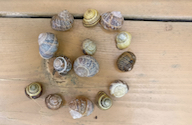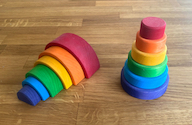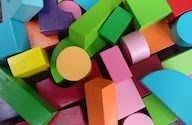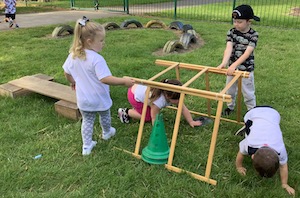Skip over navigation





Children often enjoy moving around obstacle courses, especially if these involve a variety of movements like balancing, jumping and crawling.
Adults could model a commentary using directional language, such as going around, under, over and through, encouraging children to describe their movements and to devise their own courses.
Acknowledgement: Sharon Palfreyman and children at Corrie Primary and Nursery School
Or search by topic
Number and algebra
Geometry and measure
Probability and statistics
Working mathematically
Advanced mathematics
For younger learners
Obstacle Course
Age 3 to 5
Using spatial language and reasoning





Children often enjoy moving around obstacle courses, especially if these involve a variety of movements like balancing, jumping and crawling.
Adults could model a commentary using directional language, such as going around, under, over and through, encouraging children to describe their movements and to devise their own courses.
The Activity
Set up a simple course, with for instance, planks to balance along, hoops to jump in, tunnels to crawl through and tables to go over or under.
Set up a simple course, with for instance, planks to balance along, hoops to jump in, tunnels to crawl through and tables to go over or under.
Encouraging mathematical thinking and reasoning:
Describing
Tell me what you're doing.
I am going up, I am going over, I am going down, I am going under, I am going through…
Tell me what you're doing.
I am going up, I am going over, I am going down, I am going under, I am going through…
Reasoning
Perhaps we could go across something or between some things?
What about a slalom course of cones – how far apart do they need to be?
Suppose we do the course backwards, what would come first, then?
Perhaps we could go across something or between some things?
What about a slalom course of cones – how far apart do they need to be?
Suppose we do the course backwards, what would come first, then?
Opening Out
Can you make your own obstacle course? What might you use - there are hoops, cones, large blocks and planks? Can you make some stairs? What about a circuit?
Can you make a course to get from here to there without touching the ground?
Can you make your own obstacle course? What might you use - there are hoops, cones, large blocks and planks? Can you make some stairs? What about a circuit?
Can you make a course to get from here to there without touching the ground?
Recording
Could you draw a plan or map for your obstacle course? What about adding some arrows to show people which way to go?
Could you draw a plan or map for your obstacle course? What about adding some arrows to show people which way to go?
The Mathematical Journey
Shape, space and position:
- directional language e.g. over, under, along, across, around, between, forwards, backwards, and later left and right
- visualising and making routes connecting points in different ways
- drawing plans of a course (representing 3D spatial relationships in 2D); beginning to use symbols e.g. arrows
Number:
- counting hoops or cones as children jump in or go around each one
Measures:
- comparing distances e.g. putting hoops or stepping stones nearer or further apart
- measuring how far apart to put slalom cones
Development and Variation 
Children can:

Children can:
- make obstacle courses with different specifications e.g. not touching the ground, connecting different points, making a circuit
- use stepping stones to make pathways
- visit mazes and help to design and make their own.
Resources
Crates, tyres, planks, blocks, hoops, cones, tunnels, tables, chalk (e.g. for adding annotations on the playground), large boxes…
Crates, tyres, planks, blocks, hoops, cones, tunnels, tables, chalk (e.g. for adding annotations on the playground), large boxes…
Download a PDF of this resource.
Acknowledgement: Sharon Palfreyman and children at Corrie Primary and Nursery School


